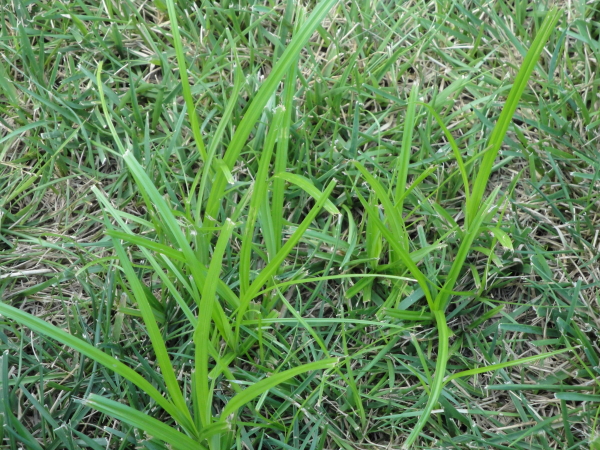 One of the fiercest weeds in lawns, flower beds and gardens is nutsedge (nutgrass). Nutsedge has a distinctive three-angled stem that is tough and fibrous. It can persist in an environment for years until the conditions are right for growth. Nutsedge spreads by seed, tubers, cultivation and can be introduced in topsoil, compost and nursery stock. One of the drawbacks to over watering or poor drainage is the sudden appearance of nutsedge. Why? Because this stuff likes it moist. So, if you have nutsedge show up take a look at the irrigation system, including possible leaks in that area.
One of the fiercest weeds in lawns, flower beds and gardens is nutsedge (nutgrass). Nutsedge has a distinctive three-angled stem that is tough and fibrous. It can persist in an environment for years until the conditions are right for growth. Nutsedge spreads by seed, tubers, cultivation and can be introduced in topsoil, compost and nursery stock. One of the drawbacks to over watering or poor drainage is the sudden appearance of nutsedge. Why? Because this stuff likes it moist. So, if you have nutsedge show up take a look at the irrigation system, including possible leaks in that area.
Controlling nutsedge is a process, not an event. Post-emergent herbicides are the most common and for me have been the most effective. Control of nutsedge is easier on a lawn than a garden because of the herbicides involved. The one with the best track record for is Sedgehammer . It will require two to three applications so read and follow the directions and keep them away from the veggies.
For the garden, we’ve tried some of the natural controls for nutsedge but all we did was hurt its feelings and not kill it. The most noninvasive way to kill nutsedge is to dig it out and retrieve the nut. The bad news is the nut may be 18” deep. The other way takes a little time. Plan on not planting a fall crop. In August or September remove all the plants from the garden. Spread about ten pounds of molasses for every 100 square feet of dirt and work it in just a little. Next, cover the entire garden with two sheets of newspaper (the black & white sheets). Then spread the mulch of your choice (we recommend cedar or hardwood mulch) over the newspaper an inch or so thick. Congratulations, you have just composted your entire garden. In February start working your garden as normal. We (my dad and I) killed about 90% of the nutsedge on the first garden we tried this process on.





